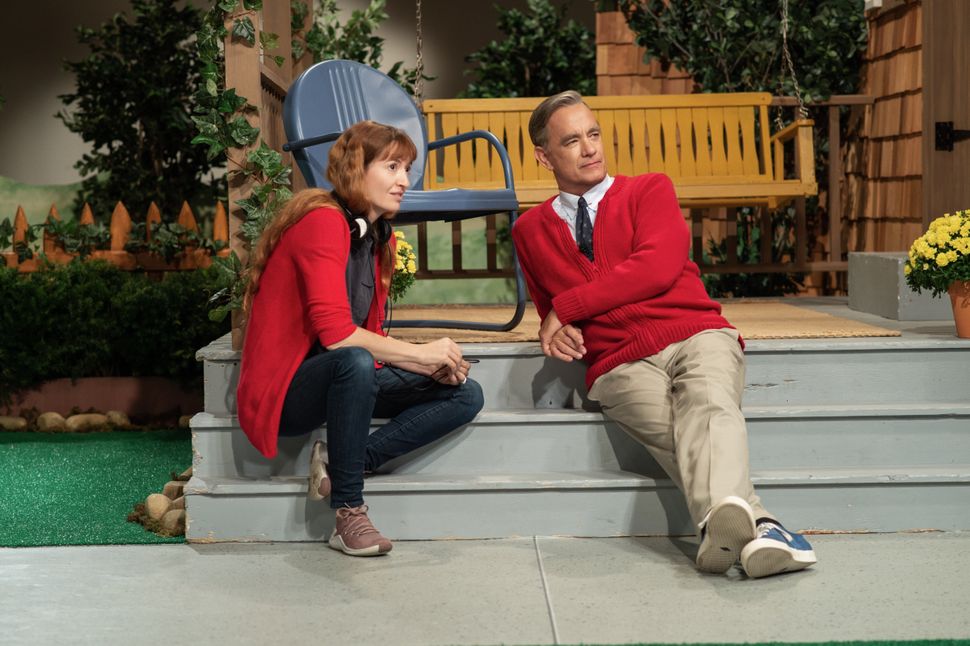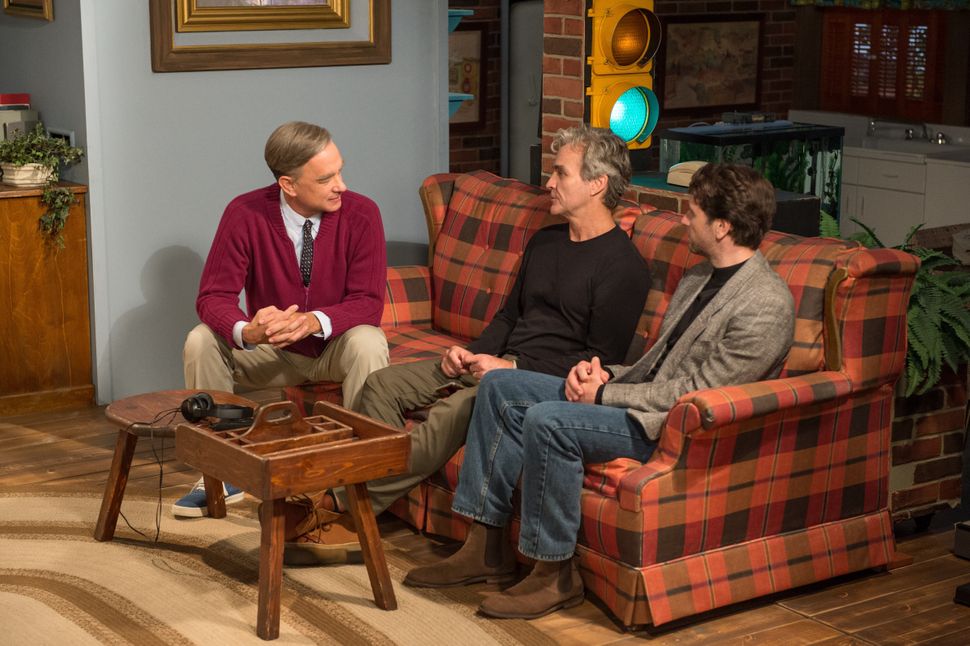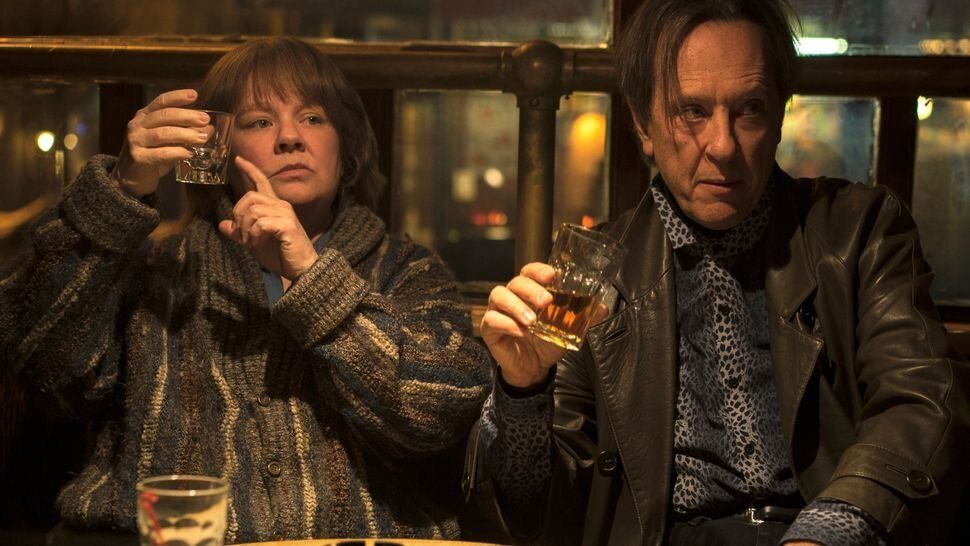[ad_1]
Over the past two years, an unlikely superstar has re-entered the zeitgeist in a major way: Fred Rogers. The gentle television host died in 2003, leaving behind more than three decades of cardigans and aphorisms. His show, “Mister Rogers’ Neighborhood,” lived on in PBS reruns and a popular spinoff (“Daniel Tiger’s Neighborhood”), but Rogers was largely a relic from an era when children weren’t born with smartphones attached to their umbilical cords.
That changed in 2018 when “Won’t You Be My Neighbor?” — Morgan Neville’s four-hanky exploration of Rogers’ legacy — became one of the highest-grossing documentaries in history. The movie was a balm, proof that a kinder world than the one we’re being subjected to can exist. Anyone expecting a seedy dive into Rogers’ private life learned that he really was who he said he was: charitable, forgiving, wise.
Rogers’ renaissance continues with “A Beautiful Day in the Neighborhood,” opening in theaters this weekend. But instead of a redundant biopic charting his rise to fame, the film fixates on Rogers’ relationship with journalist Tom Junod, who profiled him for a well-regarded Esquire cover story in 1998.
“Our movie shows his mission in action,” Heller told me at the Toronto International Film Festival, where “Neighborhood” premiered in September. “It shows how he lived his life on a day-to-day basis, and it shows how that influenced other people. It’s really a character study between these two men. It’s an examination of male anger, and it’s an examination of all the things that stop us from being our better selves.”

The script, written by “Transparent” scribes Micah Fitzerman-Blue and Noah Harpster, appeared on the Black List — an annual roster of Hollywood’s best unproduced screenplays — in 2013. It fictionalizes aspects of Junod’s life, changing his name to Lloyd Vogel and depicting him as a new dad harboring deep-seated resentment over his own father’s abdication.
“A Beautiful Day Day in the Neighborhood” begins like an episode of “Mister Rogers,” the camera panning through a colorful, handbuilt diorama of Pittsburgh, where the show was shot, before Rogers (Tom Hanks) walks out, changes into a red cardigan and performs the theme song. That miniature cityscape, with its plastic trees and chugging toy cars, becomes a recurring segue between scenes. At one point, we travel from the model of Pittsburgh to a model of New York City, where Lloyd lives and works, before returning to live action.
Along with the unconventional framing device that centralizes Lloyd, this clever stage-setting technique makes the movie feel immersive. Lines between reality and fantasy — between actual experiences and well-produced entertainment — blur. And that speaks to Fred Rogers’ impact: His show was an alternate universe unto itself, one that dared to encourage a more harmonious existence.
“I think it’s actually a more radical movie than people want it to be or know that it’s going to be,” Heller said. “I think it’s actually pushing more boundaries, in many ways, than a traditional biopic would be. I don’t think, after the documentary, making a traditional biopic would make any sense. Immediately after we found out the documentary was going to come out, we all had a moment of, ‘Huh, is this going to be good or bad for us?’ Then we all thought, ‘No, it’s great. More Fred in the world is more Fred in the world.’”
When Junod’s editor assigned him the article, Junod thought it was beneath him. Wasn’t Fred Rogers a bit, well, soft? But after the two spent time together, Junod warmed to the value of Rogers’ work. Here was someone demonstrating an alternate interpretation of American masculinity wherein men had to find constructive solutions for their rage and heartbreak just like everyone else. They remained confidants after meeting. “He gave so much to me, so much trust and friendship, without asking me to earn it,” Junod recently wrote in The Atlantic.

In depicting Fred’s curiosity about Junod’s inner turmoil, “A Beautiful Day in the Neighborhood” reveals Rogers’ layers. He, too, had to seek outlets for his anguish. It doesn’t pretend he is perfect. But the Rogers that Heller depicts didn’t scream and rage; he banged piano keys and concocted ways to advise children on “what to do with the mad that you feel.”
When Heller signed on to the project, she made two excellent changes. First, she expanded Lloyd’s wife’s presence in the story, presenting a mother figuring out how parenthood will affect her career, an element drawn from Heller’s own life. “My husband got a little mad at me,” Heller said, referring to comedian Jorma Taccone. “He saw some of the scenes and was like, ‘I thought we weren’t putting our life into our movies, but thanks a lot!’”
Then she made the inspired choice to cast Tom Hanks, arguably the most well-liked actor on the planet, as Rogers. (Matthew Rhys plays Lloyd, and “This Is Us” star Susan Kelechi Watson is his wife.) That added a bit of meta contextuality: By reputation alone, Hanks is to Hollywood what Rogers was to children’s programming.
For these reasons and more, Heller is among the most gifted filmmakers to emerge this decade. It’s easy to discount Heller’s stylistic finesse because she isn’t fashioning complicated technology like Alfonso Cuarón (“Gravity”) or desecrating cities like Christopher Nolan (“Inception”). But Heller is every bit the aesthetic mastermind. The protagonist in “The Diary of a Teenage Girl,” her 2015 debut, was a 15-year-old cartoonist whose drawings would spring to life and unfurl across the screen; during a phantasmagoric LSD trip, she imagines herself covered in feathers. Heller suffused her follow-up, 2018’s marvelous Melissa McCarthy vehicle “Can You Ever Forgive Me?,” in golden hues that mellow the central character’s hardened exterior.

Heller is used to making “underdog” films, niche indies that take a long time to finance and can only hope to find a decent-sized audience. (“A movie about this 51-year-old lesbian cat lady who barely leaves her apartment?” Heller said of “Can You Ever Forgive Me?” “Nobody was like, ‘That’s the sexy movie this year!’”) This isn’t an underdog in the same sense. “Neighborhood” is getting a splashy wide release from Sony, riding the wave of renewed Rogers enthusiasm and prolonged Hanks adoration. For her, it was nerve-racking.
“I’m very particular about every single detail of the movie, and you spend so long just agonizing over any piece of font, the performances, the edit, the sound mix, everything,” she said. “I feel this responsibility to carry all of that stuff on me. I’m responsible for the whole baby, and then I just have to let it go on one day? It feels like this emotional act that feels really scary. And then everybody’s going to judge it. This whole [publicity and awards] circuit — no offense to whatever — feels very different than the making of the movie, which is really collaborative and really loving. I try to create a safe, beautiful set that feels like we’re all a family. And then suddenly we’re, like, in competition with other people where it feels like we’re in this rat race.”
How does Heller withstand the race? By channeling Fred Rogers.
“I’m just trying to keep zen,” she said.
REAL LIFE. REAL NEWS. REAL VOICES.
Help us tell more of the stories that matter from voices that too often remain unheard.
[ad_2]
Source link

